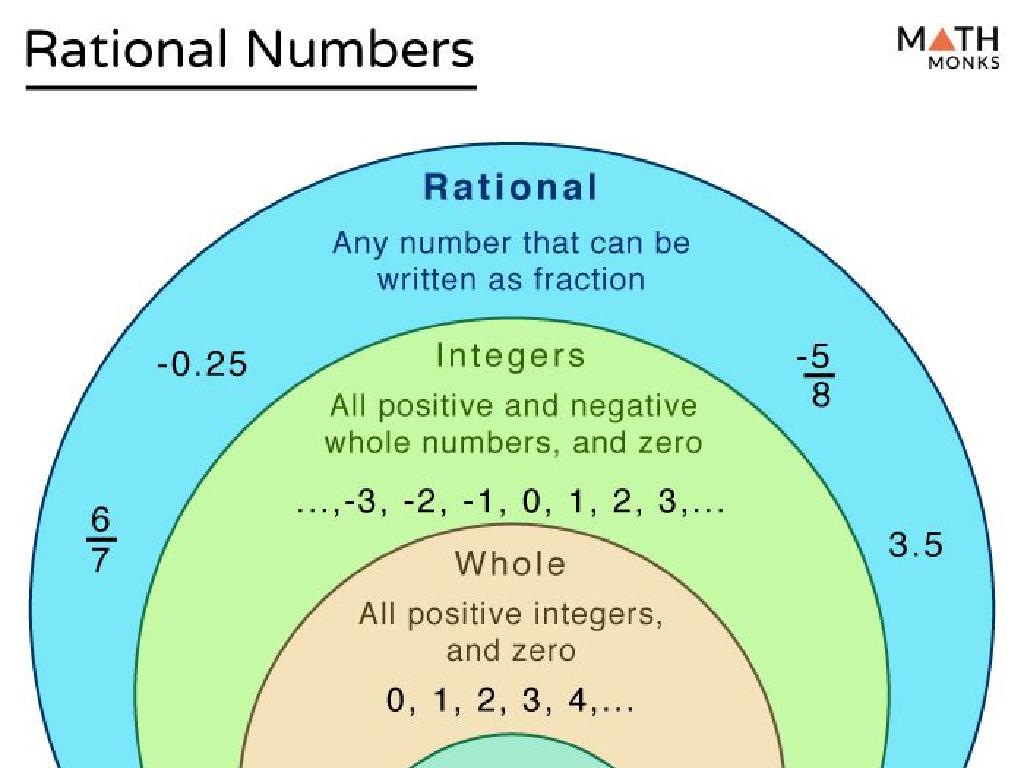Interior Angles Of Polygons
Subject: Math
Grade: Seventh grade
Topic: Two-Dimensional Figures
Please LOG IN to download the presentation. Access is available to registered users only.
View More Content
Interior Angles of Polygons
– Basics of 2D figures
– Defining polygons
– A polygon is a 2D shape with straight sides, e.g., triangles, rectangles.
– Interior angles in polygons
– The angles inside a polygon are called interior angles.
– Calculating angles’ sum
– Use formula (n-2)×180° for sum, where n is the number of sides.
|
Begin the lesson by reviewing what two-dimensional figures are, emphasizing that they have length and width but no depth. Introduce polygons as a category of 2D figures with straight sides that are fully closed. Explain that the interior angles are the angles inside the polygons. Teach students the formula to calculate the sum of the interior angles of any polygon, which is (n-2)×180°, where n is the number of sides. Provide examples for regular polygons like triangles (n=3) and quadrilaterals (n=4), and show how the formula applies. Encourage students to practice with different polygons to solidify their understanding.
Exploring Polygons
– Define a polygon
– A shape with straight sides, closed, and no curves
– Key characteristics of polygons
– Must have at least 3 sides, sides don’t cross
– Examples of polygons
– Triangle, square, rectangle
– Non-examples to clarify
– Circle, shapes with curves or open sides
|
This slide introduces the concept of polygons to the students. Begin with the definition, emphasizing that polygons are two-dimensional figures with straight sides that are fully closed. Discuss the characteristics such as the polygons having a minimum of three sides and that the sides must not cross each other. Provide clear examples of polygons like triangles, squares, and rectangles to help students identify them. Also, present non-examples such as circles and open shapes to contrast and reinforce what does not qualify as a polygon. Encourage students to think of other examples and non-examples to discuss in class.
Exploring Polygon Types
– Classify by sides: triangle to decagon
– Triangles have 3, quadrilaterals have 4, pentagons have 5, etc.
– Regular vs. Irregular polygons
– Regular polygons have equal sides and angles; irregular do not.
– Convex vs. Concave polygons
– Convex polygons have no angles pointing inwards; concave do.
– Importance of polygon types
|
This slide introduces students to the classification of polygons based on several attributes. Start by explaining the classification by the number of sides, from triangles (three sides) to decagons (ten sides). Then, distinguish between regular polygons, which have all sides and angles equal, and irregular polygons, which do not. Next, explain the difference between convex polygons, where no interior angles are greater than 180 degrees and all points on the interior are visible from any other point, versus concave polygons, which have at least one interior angle greater than 180 degrees and at least one point on the interior is not visible from another point inside the polygon. Emphasize the importance of understanding these differences when studying the properties of two-dimensional figures, such as calculating the sum of interior angles.
Exploring Interior Angles of Polygons
– Define interior angles
– Angles inside a polygon’s boundaries
– Properties of polygon angles
– Sum depends on number of sides
– Regular vs. irregular polygons
– Regular have equal angles, irregular do not
– Calculating interior angles
– Use formula (n-2)×180° for regular polygons
|
This slide introduces the concept of interior angles and their properties in different polygons. Start by defining interior angles as those found within the boundaries of a polygon. Discuss the properties, such as the sum of interior angles depending on the number of sides (n), which can be calculated using the formula (n-2)×180° for regular polygons. Highlight the difference between regular polygons, which have equal-length sides and equal angles, and irregular polygons, which do not. Provide examples of both regular and irregular polygons and show how to calculate the sum of interior angles. Encourage students to practice with different polygons to solidify their understanding.
Calculating Interior Angles of Polygons
– Sum of interior angles formula
– (n-2) x 180°, where n is the number of sides
– Example: Interior angles of a hexagon
– Hexagon has 6 sides, so sum is (6-2) x 180° = 720°
– Practice: Sum in a pentagon
– Find the sum for a pentagon with 5 sides
|
This slide introduces the formula for calculating the sum of interior angles in any polygon, which is a crucial concept in understanding two-dimensional figures. Start by explaining that ‘n’ represents the number of sides in the polygon. For the example, walk through the steps of substituting the number of sides of a hexagon into the formula to find the sum of its interior angles. Then, present the practice problem for the students to calculate the sum of interior angles in a pentagon, reinforcing their understanding of the formula. Encourage students to work through the problem and verify their answers with a peer before discussing it as a class.
Interior Angles of Regular Polygons
– Calculating interior angles
– Sum of angles = (n-2) x 180°. Divide by n for each angle.
– Interior angle of an octagon
– An octagon has 8 sides. Each angle = ((8-2) x 180°) / 8
– Practice with a decagon
– A decagon has 10 sides. Find each angle using the formula.
|
This slide introduces the method for calculating the measure of each interior angle in a regular polygon. Start by explaining the formula for finding the sum of interior angles, which is (n-2) x 180°, where n is the number of sides. Then, divide this sum by the number of sides to find the measure of each individual angle. Use an octagon as an example to demonstrate the calculation. For the practice problem, guide students to apply the formula to a decagon and calculate the measure of its interior angles. Encourage students to work through the problem and discuss their approach and answer.
Exploring Irregular Polygons
– Define irregular polygons
– A polygon with sides of different lengths and unequal angles.
– Calculating angles in irregulars
– Sum of interior angles: (n-2) x 180°, where n is the number of sides.
– Work through an example
– Example: Find angles in a pentagon with sides of varied lengths.
– Practice problem for students
– Given an irregular hexagon, calculate the missing angle.
|
This slide introduces students to the concept of irregular polygons, which are polygons with sides and angles that are not all the same. Emphasize that while these figures may look different, the method to calculate the sum of their interior angles remains consistent. Use the formula (n-2) x 180°, where n is the number of sides, to find the sum of the angles. Provide a worked example with a pentagon, showing step-by-step how to apply the formula. Then, present a practice problem with an irregular hexagon and ask students to find a missing angle, ensuring they apply the formula and their reasoning skills. This exercise will help solidify their understanding of angle calculations in irregular polygons.
Class Activity: Polygon Angle Hunt
– Find classroom polygon-shaped objects
– Work in groups on angle sums
– Use the formula (n-2)×180° for calculation
– Calculate interior angles together
– Present findings to the class
|
This interactive activity is designed to help students apply their knowledge of interior angles of polygons in a practical setting. Students will first identify objects in the classroom that resemble polygons. Then, they will work in small groups to calculate the sum of the interior angles of these polygons using the formula (n-2)×180°, where ‘n’ is the number of sides. After calculations, each group will present their findings, explaining how they determined the sum of the interior angles. For the teacher: Prepare a list of possible objects beforehand, ensure students understand the formula, and guide them through the calculation process if needed. Encourage collaboration and clear communication during presentations.
Wrapping Up: Interior Angles of Polygons
– Recap: Interior angles of polygons
– Sum of interior angles depends on the number of sides.
– Real-world relevance of polygon angles
– Knowledge of angles is used in architecture, art, and design.
– Homework: Interior angles worksheet
– Complete the provided worksheet to practice calculations.
– Practice makes perfect!
|
As we conclude today’s lesson, remind students of the key concept that the sum of the interior angles of a polygon can be determined by the number of sides. Emphasize the practical applications of this knowledge in fields such as architecture, where understanding angles is crucial for design. For homework, students are assigned a worksheet that will reinforce their skills in calculating the sum of interior angles in various polygons. Encourage them to practice diligently, as mastery of this concept is foundational for their future studies in geometry.






